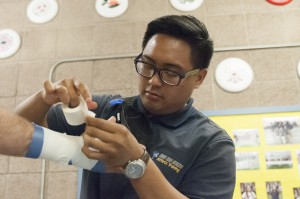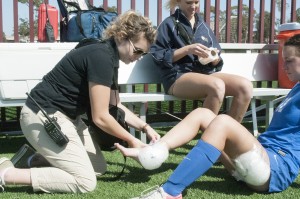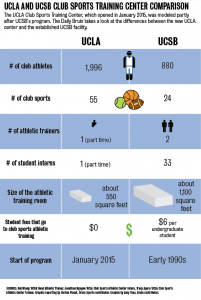Clara Goin walked into the athletic training room in the Robertson Gymnasium at UC Santa Barbara an hour before her soccer match. For the second-year biology student, coming to the center has been a routine occurrence for her the last few weeks.
“Currently I am injured but have been here for almost the past two weeks, like every day,” Goin said. “But otherwise I come in here to just get some ice so I don’t feel tight anymore. I usually come in here twice a week.”
Goin was not the only player from her team who went to the center to an athletic trainer that morning. Six other players from Goin’s team walked into the room looking for treatment for their various injuries.
“Currently we’re all kind of injured right now. There are 10 of us now that are coming in (the athletic training room) every day,” Goin said. “There is always someone who has a rolled ankle or wants to get ice after a tournament.”
While having this many injuries for just one sport might sound troubling, the room was ready. With five student athletic trainers there before the soccer match to service the team, all the athletes were treated and taken care of.
This was of the many reasons that the Director of Athletic Training Services at UCLA, Tony Spino, decided that UCSB’s program was going to be one of the models for the new club sports athletic training room in the John Wooden Center.
Spino said he knew that he needed to go to look at a successful program that had a relatively smaller budget compared to an NCAA facility. USCB fit the bill, and more.
The athletic training program for club sports at UCSB started in a trailer back in the early 1990s. As UCSB’s recreation department saw the importance and need, more and more focus went in the program. When a new recreation center opened up in 1995, space opened up in the Robertson Gymnasium for the center to be moved into.
The facility currently houses two full time trainers and 33 student athletic trainers, servicing more than 950 club athletes from across 24 club sports.
“Our center rivals any Division 1 program,” said UCSB head athletic trainer Rob Wang.
The center features five treatment tables, two wrapping benches, several modality machines and a whirl pool station, which means it meets the needs of all of the club sports athletes at UCSB, said Wang.
“It’s vital. I don’t know what I would do without it,” said Todd Heil, the women’s club soccer coach.
In addition to all of the services the athletic training facility offers, it also has a student athletic trainer’s internship, much like the internship at UCLA’s Acosta Athletic Complex. Whereas Acosta deals with NCAA athletes, UCSB has internship programs for both NCAA athletes and club sports.

The club sports athletic internship is set up so that there at least two student trainers at all the practices and home events, and with high impact sports, the student trainers will travel with the team.
“They get to know the student athletes, instead of a different trainer having to look a different injury every single time,” Heil said. “It is really incredibly important that you

Spino said it is his goal to set up an internship program similar to UCSB and Acosta, but that there are certain hurdles that they must surpass, such as funding and hiring at least two full-time trainers.
Wang said UCSB has been fortunate with its program and center. He said UCSB recognizes the importance of having the center for club athletes, and making sure the students are safe and healthy. It is because of this, Wang said, that athletes and coaches feel like their treatment is on par with any NCAA facility.
“If you look at it, it is almost like they are being treated like the NCAA Division I athletes,” Heil said.
Much of the success and the growth of the center is thanks to the UCSB’s undergraduate student body. The student body currently pays a $6 student fee that goes straight into the program. This covers the cost of the full-time trainers, equipment and staff.
The UCLA facility’s cost is covered by UCLA Recreation.
“What is … vital is having student support and having students recognize the need (for a program like this), and be able to voice and advocate for these types of services,” Wang said.
Comparing the two facilities, UCLA has a long way to go to reach the same level as UCSB’s, but to be fair, UCSB has had almost 25 years to get to where it is at.
“It might be a slow, long process … and it will benefit current students, but it will really benefit kids who come after,” Spino said.
Spino said his ultimate goal is to have a facility that rivals UCSB’s and even Acosta, and while it is going to take a while, it is certainly heading in that direction.

